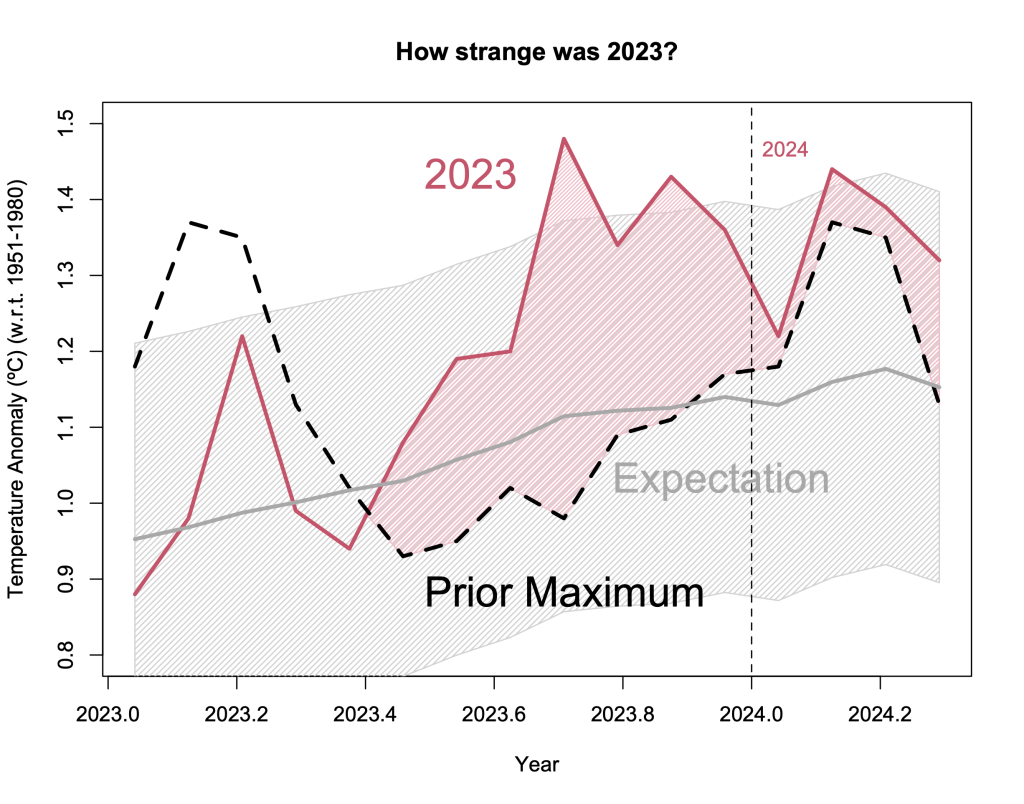RealClimate: New journal: Nature 2023?
3 min read
I don’t really get that upset by Piotr’s histrionics, it’s more amusing and quaint than anything else. My stuff is out there and published — go ponder why he’s not citing that instead of harping about some random RC comment I made on the societal benefits of predicting the climate.
In Mathematical Geoenergy (Wiley/AGU, 2018), chapter 12, I describe an ENSO model that includes a bi-annual impulse. That was over 5 years ago so I have been able to experiment with it more, trying to falsify and/or cross-validate the results as one should do with any scientific hypothesis. The recent insight may be that all the oceanic indices may have collectively reached a peak last year. Is there something modulating the bi-annual impulse, perhaps only isolating the tidal forcing signals that are longitudinally invariant? Can’t be the tropical lunar cycle because that depends on longitude (see my interactions with RC commenter Patrick27 the last few months here). How about applying only the draconic and anomalistic lunar cycles acting together, which has a beat frequency of very close to 6 years :
1/(1/Drac-1/Anom)/Year = 1/ (1/27.2122-1/27.5545)/365.242 = 5.9975 years
This is a nearly perfect even number with which to sustain/synchronize a 2-year impulse. One of the big issues with a bi-annual impulse is that it’s a metastable state. There’s nothing preventing a bi-annual cycle from missing a beat and resynchronizing on an annual cycle that’s offset by a year. IOW, there are 2 possible bi-annual pulse trains to synchronize on — say the years 2020, 2022, 2024, etc or the odd years 2019, 2021, 2023, etc. Thus the 6-year cycle — intimately tied to the 18-year Saros eclipse cycle — synchronizes the bi-annual delay and stabilizes the metastable state. For 5.9975 years, the stabilization will continue for 1/(1/5.9975 -1/6) = 14,394 years, which is the time it will take to get out of phase and flip to an odd alignment.
That’s all well and good but this approach indeed works to model all the ocean indices, including ENSO, PDO, AMO, and IOD. I have a scratch pad GIST on GitHub here, where I am collecting cross-validation experiments https://gist.github.com/pukpr/3a3566b601a54da2724df9c29159ce16
Each one of these takes a few minutes to obtain a decent fit. The insight I have as to why some of the indices have multidecadal behavior (such as AMO and PDO) has to do with the sensitivity of the anomalistic lunar cycle with respect to a bi-annual cycle. The anomalistic cycle has an implicit beat of 1/ (2*365.242/27.5545 mod 1) = 95 years, which will cause the lagged integrated response to wander about the mean value of 0. As it happens, by modeling a shorter lag response for ENSO, the multidecadal response is not as apparent. IOW, it has a faster reversion to the zero mean, and the fluctuations do not wander as much, staying interannual for ENSO instead of multidecadal.
So the fact that all the oceanic cycles have a common-mode for tidal forcing suggest that the Earth can experience a collective response that can generate an amplified peak as we measured last year. The longitudinal invariance of the specific tidal factors reinforce this behavior, much like it does for atmospheric QBO (see ibid, Chapter 11).
Perhaps the reason that this analysis has been overlooked, I looked into the etymology of the words anomalistic and draconic => an “anomalistically draconic approach” in simpler terms refers to an approach that considers irregular or unusual cycles or patterns, typically in a scientific or observational context. It implies studying phenomena that occur irregularly or deviate from the norm, focusing on their unique characteristics or occurrences rather than regular patterns. Draconic implying dragons and their remote plausibility – “don’t go there, here be dragons” – https://en.wikipedia.org/wiki/Here_be_dragons
The fact that the majority of tidal analysis concentrates on the tropical tidal factor obscured the fundamental nature of the behavior, and no wonder the draconic and anomalistic cycles have been overlooked.
Bottom-line is that this idea of tidal cycles controlling the natural variation of the ocean is not going away. It really should be considered as the default hypothesis (replacing the null), much like the earth’s orbital declination cycle is the consensus prevailing hypothesis for explaining why seasons exist. And why Milankovitch has been adopted as the consensus hypothesis for glacial cycles. Orbital forcing should always be considered before all other rationales, including the ridiculous sunspot models, which never seem to die.




